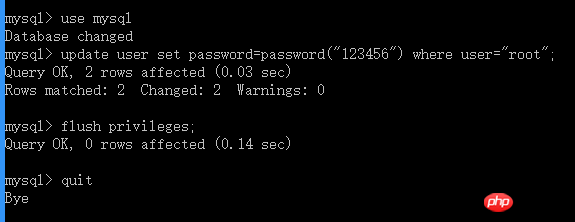A common pitfall in Mysql development - Unable to start Mysql
I was in a hurry yesterday and accidentally deleted the Mysql built-in database. As a result, I used Navicat to open it the next day. Various errors were reported, but it took me 2 hours to solve various bugs. I will record the following here so that I can accidentally make the same mistake again in the future.
Solution for unable to start Mysql
Due to various errors reported, today I ruthlessly deleted all MySql and Navicat, and reinstalled them. After the installation was completed , if you want to enter mysql under CMD to be effective, you need to configure the MySql environment variable under the system. My system is Win10. The configuration is as shown below
(1) Right click on the computer--Properties--Advanced system settings--Environment variables--Path  (2) Environment variables--System variables Path--New environment variable --This section fills in the bin path under the Mysql installation path
(2) Environment variables--System variables Path--New environment variable --This section fills in the bin path under the Mysql installation path After configuration, use CMD to
After configuration, use CMD to net start mysqlStart MySql or computer management-service-- After defining MySql startup, I had no choice but to start reporting the first error 
I searched for various solutions on the Internet and got a useful method. I found it in the MySql installation directorymy.ini file, modify default-storage-engine=INNODB to default-storage-engine=MYISAM , restart to open MySql
System error 5 occurred
Enter net start mysql under CMD and prompt system error 5. This problem is caused by not logging in as an administrator. Yes, right-click CMD to run as administrator (right-clicking on the program has no effect, you can navigate to C:\windows\System32\CMD and then right-click to run as administrator) Run
access denied for user 'root'@'localhost' (using password yes)
I thought MySql was started and Navicat could be used to connect to the database, but another error was reported. This error was solved It is relatively complicated, the steps are as follows:
(1) Stop the MySql service cmd:net stop mysql
(2) Open my. ini Find [mysqld] and then add skip_grant_tables--meaning to start MySQL Skip permission table authentication when serving
(3) Start Mysql, enter mysql under cmd to see the welcome message in English, and then enter the following use mysql connection permissions Database
(4)Change passwordupdate user set password=password("123456") where user="root";
(5)Refresh permissions flush privileges
(6) Finally exit quit
(7) Add the in step 2 skip_grant_tablesRemove it and restart MySql, it will be successful
Related recommendations:
MySQL service is starting.MySQL service cannot start up. System error
Old boy mysql video tutorial:MySQL database multiple instances Startup problem troubleshooting methods and practical troubleshooting
The above is the detailed content of A common pitfall in Mysql development - Unable to start Mysql. For more information, please follow other related articles on the PHP Chinese website!

Hot AI Tools

Undresser.AI Undress
AI-powered app for creating realistic nude photos

AI Clothes Remover
Online AI tool for removing clothes from photos.

Undress AI Tool
Undress images for free

Clothoff.io
AI clothes remover

Video Face Swap
Swap faces in any video effortlessly with our completely free AI face swap tool!

Hot Article

Hot Tools

Notepad++7.3.1
Easy-to-use and free code editor

SublimeText3 Chinese version
Chinese version, very easy to use

Zend Studio 13.0.1
Powerful PHP integrated development environment

Dreamweaver CS6
Visual web development tools

SublimeText3 Mac version
God-level code editing software (SublimeText3)

Hot Topics
 1670
1670
 14
14
 1428
1428
 52
52
 1329
1329
 25
25
 1274
1274
 29
29
 1256
1256
 24
24
 MySQL's Role: Databases in Web Applications
Apr 17, 2025 am 12:23 AM
MySQL's Role: Databases in Web Applications
Apr 17, 2025 am 12:23 AM
The main role of MySQL in web applications is to store and manage data. 1.MySQL efficiently processes user information, product catalogs, transaction records and other data. 2. Through SQL query, developers can extract information from the database to generate dynamic content. 3.MySQL works based on the client-server model to ensure acceptable query speed.
 Explain the role of InnoDB redo logs and undo logs.
Apr 15, 2025 am 12:16 AM
Explain the role of InnoDB redo logs and undo logs.
Apr 15, 2025 am 12:16 AM
InnoDB uses redologs and undologs to ensure data consistency and reliability. 1.redologs record data page modification to ensure crash recovery and transaction persistence. 2.undologs records the original data value and supports transaction rollback and MVCC.
 MySQL vs. Other Programming Languages: A Comparison
Apr 19, 2025 am 12:22 AM
MySQL vs. Other Programming Languages: A Comparison
Apr 19, 2025 am 12:22 AM
Compared with other programming languages, MySQL is mainly used to store and manage data, while other languages such as Python, Java, and C are used for logical processing and application development. MySQL is known for its high performance, scalability and cross-platform support, suitable for data management needs, while other languages have advantages in their respective fields such as data analytics, enterprise applications, and system programming.
 How does MySQL index cardinality affect query performance?
Apr 14, 2025 am 12:18 AM
How does MySQL index cardinality affect query performance?
Apr 14, 2025 am 12:18 AM
MySQL index cardinality has a significant impact on query performance: 1. High cardinality index can more effectively narrow the data range and improve query efficiency; 2. Low cardinality index may lead to full table scanning and reduce query performance; 3. In joint index, high cardinality sequences should be placed in front to optimize query.
 MySQL for Beginners: Getting Started with Database Management
Apr 18, 2025 am 12:10 AM
MySQL for Beginners: Getting Started with Database Management
Apr 18, 2025 am 12:10 AM
The basic operations of MySQL include creating databases, tables, and using SQL to perform CRUD operations on data. 1. Create a database: CREATEDATABASEmy_first_db; 2. Create a table: CREATETABLEbooks(idINTAUTO_INCREMENTPRIMARYKEY, titleVARCHAR(100)NOTNULL, authorVARCHAR(100)NOTNULL, published_yearINT); 3. Insert data: INSERTINTObooks(title, author, published_year)VA
 MySQL vs. Other Databases: Comparing the Options
Apr 15, 2025 am 12:08 AM
MySQL vs. Other Databases: Comparing the Options
Apr 15, 2025 am 12:08 AM
MySQL is suitable for web applications and content management systems and is popular for its open source, high performance and ease of use. 1) Compared with PostgreSQL, MySQL performs better in simple queries and high concurrent read operations. 2) Compared with Oracle, MySQL is more popular among small and medium-sized enterprises because of its open source and low cost. 3) Compared with Microsoft SQL Server, MySQL is more suitable for cross-platform applications. 4) Unlike MongoDB, MySQL is more suitable for structured data and transaction processing.
 Explain the InnoDB Buffer Pool and its importance for performance.
Apr 19, 2025 am 12:24 AM
Explain the InnoDB Buffer Pool and its importance for performance.
Apr 19, 2025 am 12:24 AM
InnoDBBufferPool reduces disk I/O by caching data and indexing pages, improving database performance. Its working principle includes: 1. Data reading: Read data from BufferPool; 2. Data writing: After modifying the data, write to BufferPool and refresh it to disk regularly; 3. Cache management: Use the LRU algorithm to manage cache pages; 4. Reading mechanism: Load adjacent data pages in advance. By sizing the BufferPool and using multiple instances, database performance can be optimized.
 MySQL: Structured Data and Relational Databases
Apr 18, 2025 am 12:22 AM
MySQL: Structured Data and Relational Databases
Apr 18, 2025 am 12:22 AM
MySQL efficiently manages structured data through table structure and SQL query, and implements inter-table relationships through foreign keys. 1. Define the data format and type when creating a table. 2. Use foreign keys to establish relationships between tables. 3. Improve performance through indexing and query optimization. 4. Regularly backup and monitor databases to ensure data security and performance optimization.




